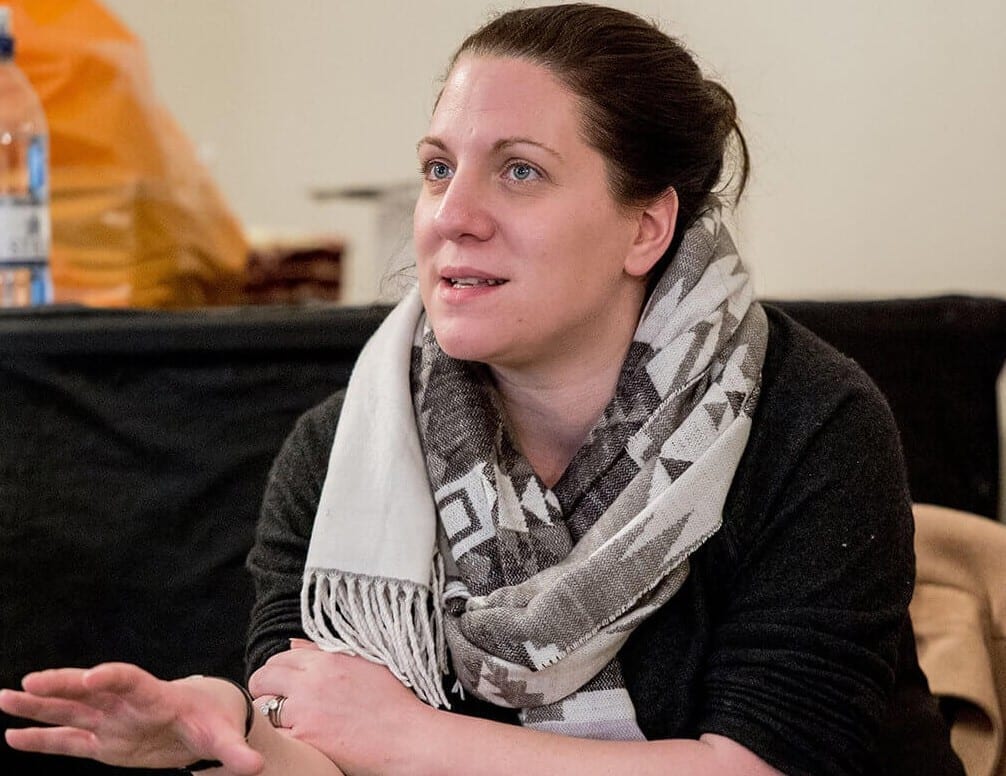Clare Lizzimore won the Olivier Award for ‘Outstanding Achievement in an Affiliate Theatre’ for her production of Mike Bartlett’s Bull in 2015. She is currently directing a revival production with a new cast at the Young Vic starring Susannah Fielding, Max Bennett, Marc Wootton and Nigel Lindsay. Sophia Chetin-Leuner spoke to her about returning to The Maria, and the challenges involved in directing this intricate play in such an intimate space.
SCL: Why is the performance space so important for a play like Bull?
CL: Bull is written with no stage directions, rather it puts its emphasis on language. The characters and the dynamic of how they operate with each other, in a way, are the scenography. So you’ve got to start by thinking about how the space you set this in is going to provide a context that supports putting language, and action, and interaction first. It’s called Bull so you have to interrogate why. Is it about Bull-fighting, Bullying, Bull-shit, is it somehow riffing on all three? If you try to do something too naturalistic with the play you may not allow the heightened sense of sport, and event, and ritual to come through, if you set it completely metaphorically you may miss the real life truths of what these people are fighting for. I think with Mike Bartlett’s work the way he marries form and content ‘is’ the play. If you get the staging metaphor right, you’ll reveal what the play is, what it’s saying and what it’s ‘doing’.
SCL: The design is so intrinsic to the play, with this in mind, how closely did you work with your designer?
CL: A director / designer relationship is one of the most important working relationship in theatre, as you’re crafting the 3-D visual metaphor for the play, it provides the context for everything. On Bull, Soutra Gilmour and I worked extensively going through all the myriad versions of what this play could be: is it an office, is it a bull-ring, is it both, therefore is it glass and steel, or sand and wood and blood that we are encountering? Does it have furniture, are there props, or is there another way to symbolize what the characters refer to? If there are props where do they live in the space? You have to work through every possibility until you start to define how you see the drama operating.
SCL: What are some of the challenges when working in the Maria?
CL: The Maria is a gift of a space – you can literally do anything in it and configure it in any way you wish. The challenges of the show are more about the play itself – it’s fast and furious, it deliberately has a singular, deadly, narrative that needs to be pursued rigorously to deliver the decisive blow at the end of the play. It doesn’t really waver in its narrative structure, in that it deliberately doesn’t really have a conventional narrative with the twists and turns that we expect as audience members. Instead it pushes us to watch something that is more of a ritual than a story. But it’s also funny. So that’s your challenge: how to deliver on the wit, and the poison, and the narrative that isn’t going to do what we want it to do.
SCL: How does the Maria compare to the other studio spaces you’ve worked in? (Royal Court Upstairs, the Bush, the Roundabout)
CL: Each space has been a gift to work in. Luckily, each of these spaces has the flexibility to configure really in any way, so I’ve been lucky to be able to work on new writing in contexts where you can do what the play demands.
SCL: When you took Bull on tour, how did the other spaces compare? Do you favor the Maria? Why/why not?
CL: Bull has had an extraordinary journey as a production. What’s thrilling to any theatre practitioner is the ability for the work you make to be appreciated by diverse and large audiences. There’s a strand of this play that’s about graft, the everyman, and how to function in a world that’s progressively more results driven, success orientated, and where qualities that used to be prized, like kindness and dignity, and fair-play mean very little, as this is a world of ruthless operators. Those themes read in a certain way where we opened the play in Sheffield, perhaps referencing the redundancy and the persecution of the underdog. The space reflected this usefully in that alongside the ringside seats, in the Sheffield studio there’s a gallery, so people could chose to sit slightly removed from the action, looking down on it, and judging it. When we got to New York, the audience there meant the focus was perhaps more on success, what that means, and who gets left behind. In that way, the audience was more on the same level, and facing each other – perhaps suggesting that this could happen to any of us. In the Young Vic, where we’re hoping to reach an audience of city workers, all of them well dressed, and match fit, the space is perhaps the most like a sporting arena – with breeze block walls, tiered seating down to the ringside. This gears the audience up to watch an event or a fight, and the competitive London audience seems to respond to that. Not all of these adjustments have been conscious, as we’ve obviously had to adapt to the different spaces we’re in, but it’s interesting to me the connection between the thematic focus and the changing way the audience watch the play.
Clare Lizzimore directs Mike Bartlett’s Bull at the Young Vic, 11 December 2015 – 16 January 2016. For more information and to purchase tickets visit www.youngvic.org | Box Office 020 7922 2922

